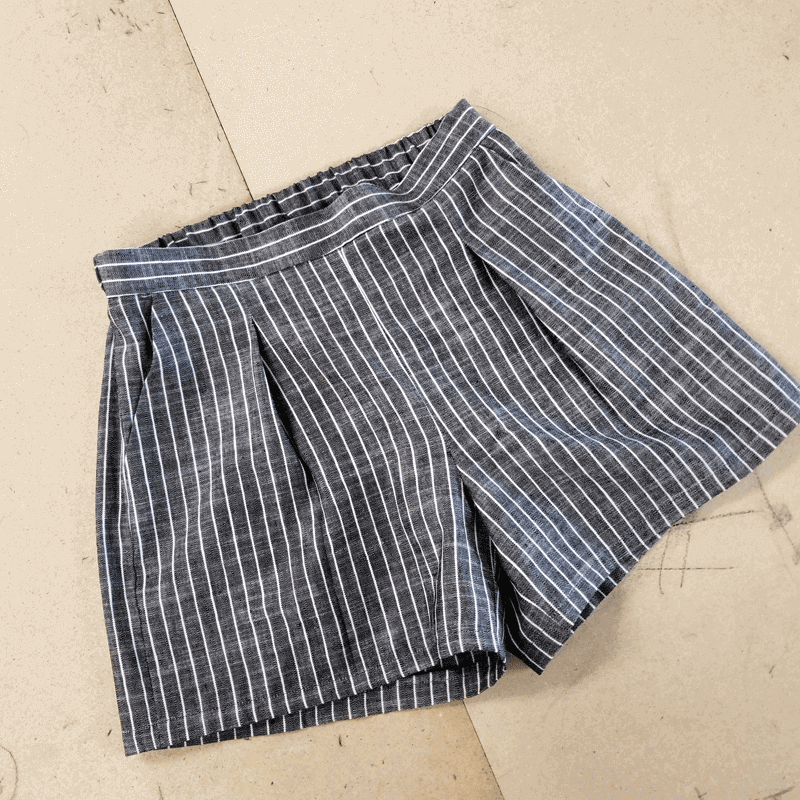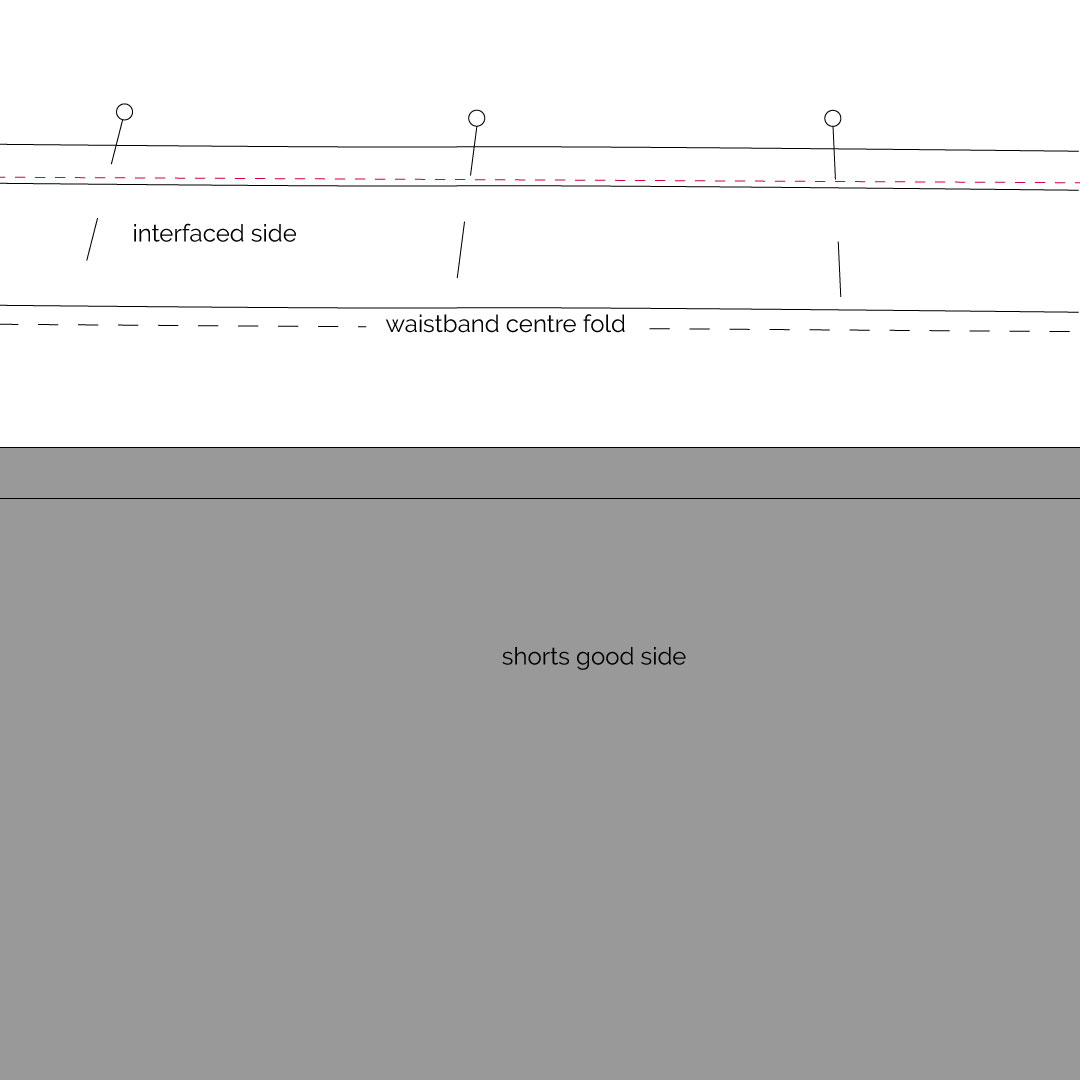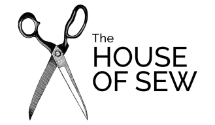Fold Shorts Tutorial

Tools & Materials
Fold Shorts Pattern
- 1 metre – 1.25 metre of Fabric (140cm wide)
- 3/4″ Elastic
- Thread
- Tailors Chalk
- Dressmaking Pins
- Dressmaking Shears
Cutting
1. Start by folding your fabric in half, selvedge to selvedge.
2. Lay out and pin (or trace) pattern pieces according to your fabric width. Remember, the grain line is always parallel to the selvedge. Cut and notch accordingly.
3. Once you have your pieces cut out and notched, start with matching and ironing your pleats. Work from the right side of the fabric facing you. Fold the from the middle notch, folding back the notch closest to the pocket. Baste pleats in place.




Pockets
4. Match top pocket bag with the front of the shorts, good side to good side. Stitch pocket in place with a 1 cm seam allowance. Press and serge or zig-zag the raw edges.
*Optional: Edge stitch on the top pocket bag for a cleaner finish. Remember to catch the seam allowance on the wrong side.
5. Align the bottom and top pocket bag. Stitch and finish the raw edges.
6. Baste the top of pocket bag to the front of the shorts to prevent it from moving around.
7. With the right sides together, line up the back and front side seams and inseams of the shorts. Stitch, press, and lastly, serge or zig-zag the raw edges.
8. Repeat steps 4-7 for the other leg.

Crotch Seam
9. One leg at a time, place the front and back leg pieces right sides together. Pin from the crotch point down to the hem of the shorts. Pin the sides of the shorts together. Backstitching at the beginning and at the end, sew these two pieces together. Repeat for the other leg.
10. When the seams are all nicely pressed, we’re going to join the two separate leg pieces together by placing one leg inside the other and sewing around the crotch curve.
With one leg the right way out and the other leg inside out. Place the inside out leg into the right sides out one, so that right sides are together.
11. Line up the crotch seam, making sure to match the edges, notches and the inside leg seams. Pin the two legs together and stitch in place. Remember seam allowance is still 1 cm all the way around.
12. Once this is done, press the seam allowance open all the way around. It’s quite a tricky area to press, so you might find a tailor’s ham or sausage will help.


Waistband – Interfacing
13. Place the interfacing glue side down, on the wrong side of the front waistband. Make sure to place it 1 centimetre away from the side and bottom edges of the waistband. Iron with the appropriate heat setting.
14. Match the waistband side seams, stitch and press. Matching the long sides together, fold the waistband in half and press.
15. Align top edges of shorts and interfaced section of the waistband together, pin, and stitch in place.
16. Press the seams upwards into the waistband. The goal is to hide the seams in between the waistband.
– Press the unfinished outer edge of the waistband in towards the wrong side. This edge should be pressed approximately 2-3 mm less than the final seam allowance for this edge. For example, if the waistband seam allowance is 3⁄8″ (1 cm), this edge of the waistband should be pressed 7-8 mm.
Waistband
17. Now match up the edge of the elastic with the waistband side seams whilst carefully aligning it between the fold and stitched edge of the waistband. Pin in place at the side seams, ditch stitch elastic in place. Attach a safety pin to the other end of the elastic so that you can pull the elastic through the back of the waistband later.
18. Time to close off majority of the waistband! The folded edge should be neatly pinned along the seam so that it covers the stitch line. Make sure to insert the pin directly into the ditch of the seam, securing the underside of the binding.
Pin from the right side of the garment for easier removal when you sew. Leave a gap about 6-8 cm wide at the waistband side seam so that you can pull the elastic through the back of the waistband later.
*Check that the pins have captured the folded binding edge on the underside of the garment.
19. Use the edge joining foot if you have one to complete the next step, it will make your life easier! A regular foot will work but will require more patience. Place the machine’s needle in the ditch of the seam. Sew slowly and pull the fabric lightly on either side of the needle as you guide it through the ditch. Remove the pins as you approach them. The finished stitch is invisible on the right side of your garment while capturing the inside folded edge.
20. Finally! Time to pull the elastic through the back casing of the waistband. Grab onto the safety pin while pushing excess fabric towards the opposite end of the gap, eventually exposing the elastic.
21. Again, align the edge of the elastic with the waistband side seam whilst carefully aligning it between the fold and stitched edge of the waistband. Pin in place at the side seams, ditch stitch elastic in place.
22. Close off the gap using the same ditch stitch method.
23. Voilà! Time to admire your work!

